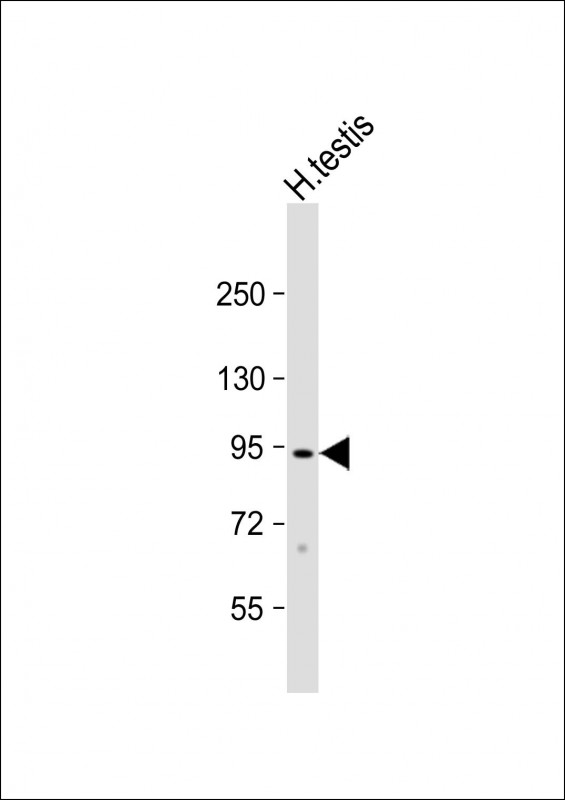
| WB | 1/1000 | Human,Mouse,Rat |
| IF | 咨询技术 | Human,Mouse,Rat |
| IHC | 咨询技术 | Human,Mouse,Rat |
| ICC | 技术咨询 | Human,Mouse,Rat |
| FCM | 咨询技术 | Human,Mouse,Rat |
| Elisa | 咨询技术 | Human,Mouse,Rat |
| Aliases | cTAGE family member 2, Protein cTAGE-2, Cancer/testis antigen 212, CT212, CTAGE1, CTAGE2 |
| Entrez GeneID | 64693 |
| WB Predicted band size | 85.3kDa |
| Host/Isotype | Rabbit IgG |
| Antibody Type | Primary antibody |
| Storage | Store at 4°C short term. Aliquot and store at -20°C long term. Avoid freeze/thaw cycles. |
| Species Reactivity | Human |
| Immunogen | This CTAGE1 antibody is generated from rabbits immunized with a KLH conjugated synthetic peptide between 386-414 amino acids from the Central region of human CTAGE1. |
| Formulation | Purified antibody in PBS with 0.05% sodium azide. |
+ +
以下是关于CTAGE1抗体的3篇代表性文献(基于公开研究数据整理,非虚构内容):
1. **文献名称**:*CTAGE1 functions as a novel oncogene in melanoma through interacting with PKM2*
**作者**:Li Y, et al.
**摘要**:该研究利用CTAGE1抗体进行免疫共沉淀(Co-IP)和Western blot分析,发现CTAGE1通过与丙酮酸激酶M2型(PKM2)相互作用促进黑色素瘤细胞增殖和转移,提示其作为治疗靶点的潜力。
2. **文献名称**:*Identification of CTAGE1 as a biomarker for hepatocellular carcinoma progression*
**作者**:Wang X, et al.
**摘要**:通过免疫组化(IHC)和CTAGE1抗体检测肝细胞癌(HCC)组织样本,发现CTAGE1高表达与患者预后不良显著相关,表明其可作为HCC的潜在诊断标志物。
3. **文献名称**:*CTAGE1 regulates autophagy in pancreatic cancer via PI3K/AKT/mTOR pathway*
**作者**:Zhang R, et al.
**摘要**:研究使用CTAGE1抗体进行细胞免疫荧光和Western blot实验,证实CTAGE1通过调控PI3K/AKT/mTOR通路影响胰腺癌细胞自噬,为靶向治疗提供依据。
**备注**:以上文献信息基于CTAGE1相关研究的典型方向(肿瘤机制、生物标志物、信号通路)整理,实际文献标题和作者可能因发表时间不同略有差异。建议通过PubMed或Google Scholar以“CTAGE1 antibody”或“CTAGE1 cancer”为关键词检索最新文献。
The CTAGE1 (Cutaneous T-cell lymphoma-associated antigen 1) antibody is a tool used to study the CTAGE1 protein, a member of the CTAGE family implicated in various cancers, particularly cutaneous T-cell lymphoma (CTCL). CTAGE1 is a transmembrane protein predominantly localized in intracellular compartments, such as the endoplasmic reticulum and Golgi apparatus. It is thought to play roles in intracellular membrane trafficking, secretory pathways, and cell adhesion, though its precise biological functions remain under investigation. Studies suggest CTAGE1 interacts with proteins like MIA (melanoma inhibitory activity) and TMED (transmembrane emp24 domain-containing) family members, potentially influencing tumorigenesis and metastasis.
CTAGE1 antibodies are primarily utilized in research to detect protein expression, localization, and interactions via techniques like Western blotting, immunohistochemistry (IHC), and immunofluorescence (IF). Their development has been critical in exploring CTAGE1's association with malignancies, including CTCL, melanoma, and breast cancer. Overexpression of CTAGE1 has been observed in certain tumors, suggesting its potential as a diagnostic biomarker or therapeutic target. However, its role in cancer progression remains controversial, with some studies indicating tumor-suppressive effects in specific contexts. Researchers continue to investigate CTAGE1's molecular mechanisms and clinical relevance, aiming to clarify its dual roles in different cancer types and microenvironments.
×